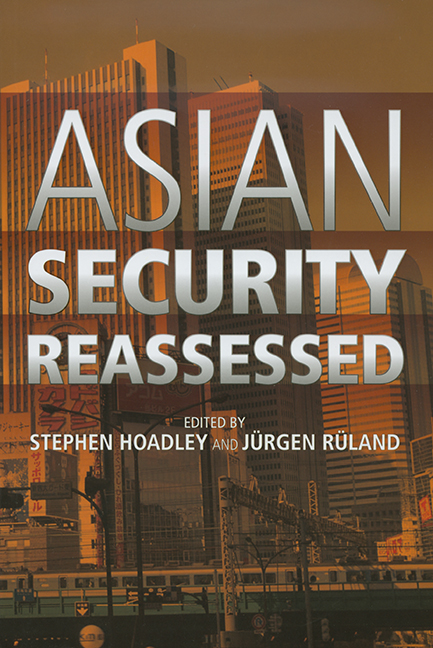Book contents
- Frontmatter
- Contents
- Acknowledgements
- About the Contributors
- List of Abbreviations
- Preface
- Part One Approaches to Asian Security
- Part Two Security Management by Asian States and Regional Institutions
- 2 Asia from Colonialism to Culturalism
- 3 Japan and East Asian Regional Security
- 4 China's Security Strategy and Policies
- 5 United States Security Policies in Asia
- 6 Regional Security Institutions: ASEAN, ARF, SCO and KEDO
- Part Three Non-Traditional Challenges to Asian Security
- Part Four New Concepts of Asian Security
- Index
3 - Japan and East Asian Regional Security
from Part Two - Security Management by Asian States and Regional Institutions
Published online by Cambridge University Press: 21 October 2015
- Frontmatter
- Contents
- Acknowledgements
- About the Contributors
- List of Abbreviations
- Preface
- Part One Approaches to Asian Security
- Part Two Security Management by Asian States and Regional Institutions
- 2 Asia from Colonialism to Culturalism
- 3 Japan and East Asian Regional Security
- 4 China's Security Strategy and Policies
- 5 United States Security Policies in Asia
- 6 Regional Security Institutions: ASEAN, ARF, SCO and KEDO
- Part Three Non-Traditional Challenges to Asian Security
- Part Four New Concepts of Asian Security
- Index
Summary
INTRODUCTION
This chapter examines Japan's changing regional security context at the start of the twenty-first century. Japan's own approach to security issues throughout the post-war period has been simultaneously constrained by particular domestic forces and buffeted by international pressures. Forced to renounce the use of conventional and nuclear forces in the region in the wake of defeat and occupation after 1945, the Japanese Government adopted what became known as a “pacifist” constitution and the Japanese people supported the later introduction of Japan's so-called three nonnuclear principles. At the same time, since regaining its independence in 1952 Japan has been pushed to assume greater international military burdens. These contradictory forces, as will be shown below, have facilitated an often pragmatic and changing security posture by the Japanese government, within its region and beyond.
This chapter will examine the principal issues related to Japanese security concerns with the region, particularly since the ending of the Cold War. The first section provides a brief historical overview of how Japan's security relations in its region have developed over time. The second section looks at the main issues concerning Japan's security at the start of the new century and examines the more frequent adoption of security alternatives. Section 3 looks at three major security concerns: anti-terrorism in the wake of 11 September 2001, North Korea and the war in Iraq. The conclusion assesses the extent to which Japan's pragmatism is capable of dealing with this changing security environment, and examines how far the Japanese Government may be seen to be developing a “comprehensive security” strategy.
HISTORICAL OVERVIEW
In the wake of defeat in 1945 Japan was occupied for almost seven years by the Supreme Command for the Allied Powers (SCAP). This predominantly American presence on Japanese soil ensured that the processes of demilitarization and democratization were set in train. Despite later U.S. calls for the rearmament of Japan, the revised Constitution of 1946 set in place what became the mantra of the Japanese security élite: Article Nine. This reads as follows:
Aspiring sincerely to an international peace based on justice and order, the Japanese people forever renounce war as a sovereign right of the nation and the threat or use of force as means of settling international disputes.
- Type
- Chapter
- Information
- Asian Security Reassessed , pp. 66 - 85Publisher: ISEAS–Yusof Ishak InstitutePrint publication year: 2006



